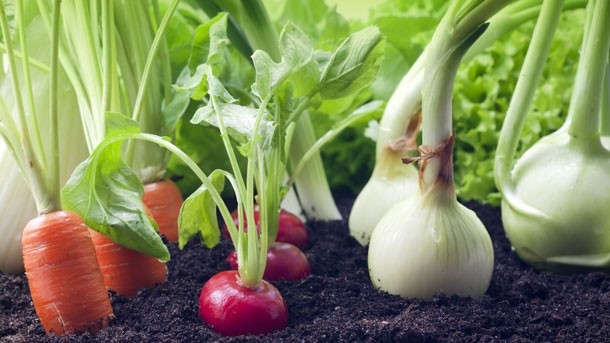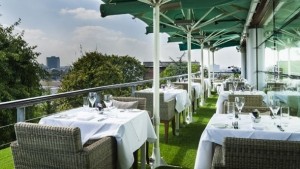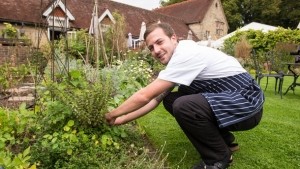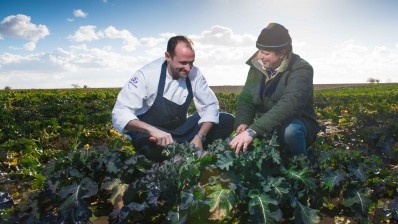How to successfully grow your own produce

As green-fingered chefs and restaurateurs will tell you, there are numerous benefits to growing your own, so with the arrival of spring and the garden starting to look busier, we speak to the operators already doing it to find out what is involved and their top tips for success.
Find a growing space
If you’re already thinking of leaving this page because you have limited, or no outdoor space attached to your business, please don’t. Growing space for vegetables, fruit, herbs and flowers, as Mark Thornhill, owner of The King's Head in Hursley, near Winchester will tell you, can be found in almost any place that can hold soil and gets some light.
"We've (Mark and wife Penny) grown produce in all four of the pubs we've owned now and we love it. In our first pub (The Bell at Fetcham) we started growing mint to go in the Pimms and converted long hanging baskets that were bolted to the wall - a bit like a window box - into a herb garden. We went on to grow vegetables and fruit," he says.
"Now at The King's Head we've started planting in any available space. We've got hops on frames in barrels out the front and bay trees at the front door. In our hanging baskets we're going to be planting some hanging tomatoes and wild strawberries. Next we're converting our garden. It's nothing huge, just the size of a garden at a three-bed semi. We want customers to sit out there too, so we can't take it all, but we'll use all the space we can."
He adds: "You really don't need much space. In fact, my advice is start simple and start small. You can just buy a simple tub of herbs and keep them at the kitchen door."
Kensington restaurant Babylon at The Roof Gardens has been growing herbs within a four metre square space on the roof garden since the restaurant opened in 2001. During the summer months an extra metre against a verticle wall is used to grow salad vegetables.
"Being a sustainable restaurant we are very aware of where we source our ingredients and always endeavour to do as much as we can for the environment," says The Roof Gardens' head gardener David Lewis, who believes being in a busy city-centre location shouldn't put anyone off growing their own.
"We wanted to demonstrate what was possible in a relatively small urban space and to make use of what we had available," he adds.
Be realistic about what you can achieve
While there is potential to grow produce in any available space, be realistic about your yield and also what will grow in the climate you're in. Basil and coriander are herbs that have never grown well for Thornhill or at Babylon for example, while mint and hardier herbs such as rosemary, sage and marjoram appear to do well whoever is growing them.
Emily Scott at St Tudy Inn in north Cornwall finds aubergines tough to grow and Babylon's Lewis says it can be a challenge to remember to germinate chilli seeds with heat in January, but in some cases troublesome crops can become bumper ones if close attention is paid to them.
"As long as we can stop the barmen and chefs harvesting the whole plant it has been quite easy," says Babylon's Lewis. "As we use no chemicals this has also presented challenges but it does mean that anything we supply to the kitchens or bars is free of pesticides."
If you want high yield, Thornhill recommends planting fast-growing vegetables such as runner beans, courgettes and pumpkins. Fruit trees, such as apple and cherry also require little effort, but in the right climate can produce plenty of fruit.
At Jeremy's restaurant, situated within Borde Hill Garden near Haywards Heath in West Sussex, a number of vegetables, herbs, fruit and flowers are grown for use in the kitchen.
"We have always used flowers from the garden and herbs such as marjoram, sage and rosemary, plus wild garlic in spring. We also use a lot of borage flowers and were one of the first I know of to use lovage in our cooking," says owner Jeremy Ashpool, who has recently extended his garden area to grow peas and broad beans, white and red currants and wild strawberries.
The restaurant also has its own grape vine with fruit used as a garnish for desserts or to make grape jelly.
One thing is clear, however, unless, like Chewton Glen, you have a kitchen garden, orchards and 130 acres of land to play with, it is unlikely that growing your own produce will mean you can end the relationship with your greengrocer.
In the full height of summer, Ashpool estimates that a third of the menu at Jeremy's will be made up of produce grown up on site. The amount is similar for Scott at St Tudy Inn.
"My menu is small and changes daily," she says. "I am lucky enough to have Ross Geach supply the Inn so at the moment the Inn's kitchen garden provides roughly 30 per cent of what I cook with."
"When we had our pub with a bigger garden about 10 per cent of the menu included produce grown by us," adds Thornhill. "Unless you have acres of land you couldn’t sustain the whole kitchen, but even doing a little bit does make a difference and to me there's nothing better than knowing you've grown your own."
Don't do it all on your own
While you need to feel passionate about growing your own, if you want to make a real success of it, it's worth getting the experts in. At Craft London, Stevie Parle's new Greenwich Peninsula restaurant opening this month, its Market Garden, set within 45 acres of gardens and green space, has been designed by gardening expert Alys Fowler.

Fowler has taken the headache out of planning and planting a garden for Parle by creating an orchard and kitchen garden for him, with 20 containers in which will grow edible flowers, baby vegetables and unusual herbs such as myrtle and hyssop, plus numerous types of mints for tea.
Its creation is part of a clear 'quality in production' vision for the business, which includes having its own coffee roaster and meat-curing room on-site, so starting out with help from professionals was key, but it can also be beneficial for those who are simply looking to create a smaller kitchen garden on-site.
Thornhill, who has several years of growing his own, is using the services of local professional gardener Andrew Bentley aka The Gardening Gent, this time around. Bentley, who lives nearby and was interested in the business, is helping to plan the garden and has helped set up irrigation for the hanging baskets.
"We've had four pubs over the years and in every one we've grown herbs and vegetables," said Thornhill. "This time we’re going to do a lot more, so we've got Andrew in to help. They way I see it is we spend so much time and attention on décor and the inside that why shouldn't we extend that to outside?"
At Jeremy's, two gardeners are employed to look after the restaurant's gardens, which sit within the Borde Hill Garden outside Haywards Heath. "They start getting things ready around February time and then each week they might put in about four or five hours each," says Ashpool.
Aside from the planning and planting, care will entail a few minutes watering and weeding plants each day, something Thornhill says can be simply built into a daily routine.
Shout about your efforts
Finally, if you have successfully grown your own produce and it is being served up to your customers, don't forget to share your achievements with your staff and diners.
"My ethos is very simple - I always source the very best local suppliers and finest ingredients and combine them simply and instinctively in my cooking, but the most wonderful thing is being able to tell our customers what comes from the kitchen garden," says Scott, who has managed to pass on her green-fingered enthusiasm to her chefs.
"All my chefs take an avid interest in the kitchen garden and are most excited - even when recently the violas suddenly came into bloom."
Thornhill's chefs have also caught the growing bug. "It's good to see the chefs out there picking herbs and chatting to the guests," he said. "They really like it and I find it gives them a real respect for the produce. One of our chefs has even set up her own kitchen garden at home now."
With all the effort going into growing and sourcing produce, however, Thornhill realised he had neglected to pass that on to his customers.
"We were buying lamb from Romsey, which is just seven miles away, but we just said 'roast lamb' on our menu. Now it says Romsey roast lamb, and that's much better," he says.
"We’ve also got fruit trees - crab apple, apple and cherry - and we’ll use the fruit from those where we can. If you can say ‘our garden apple crumble’ it sounds better than ‘apple crumble’.
"You really can’t get better. It's the honesty of it. We are not telling you any fibs about where our produce is from."



































